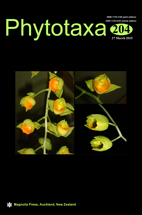Abstract
Navicula striolata was originally described as N. digitoradiata var. striolata from modern material collected in Sweden. After examination of a sample collected from Belgium, the variety was transferred to N. reinhardtii as N. reinhardti var. gracilior. From this time a large mix up of these and related taxa was observed in the literature. A similar species, Navicula rumaniensis had also been established in 1934 from Neogene Romanian materials but there has been much confusion regarding the status of these taxa, leading to a poor understanding of their distribution. In this study, type material of Navicula digitoradiata var. striolata, N. reinhardtii var. gracilior and N. rumaniensis are revised using light and scanning electron microscopy in order to clarify their identity and to investigate possible conspecificity. The results indicate that these species are not synonyms. Conspecificity of the modern N. digitoradiata var. striolata and N. reinhardti var. gracilior was confirmed and lectotypes of both varieties have been designated whereas N. rumaniensis proved to be a separate species. In addition, the study of Neogene material from Bulgaria revealed the presence of a new Navicula taxon—N. friedelhinziae. The morphology of these and similar taxa is discussed.

